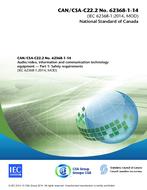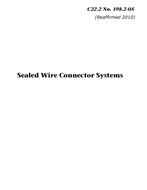Click here to purchase
Z341 SERIES-18 – Storage of hydrocarbons in underground formations
Preface
This is the fifth edition of CSA Z341 Series, Storage of hydrocarbons in underground formations, which consists of CSA Z341.1, Reservoir storage, CSA Z341.2, Salt cavern storage, and CSA Z341.4, Salt cavern waste disposal. It supersedes the previous editions published in 2014, 2010, 2006, and 2002. It also replaces CSA Z341, published as a single Standard in 1998 and 1993. This Series of Standards covers the storage of hydrocarbons and wastes from hydrocarbon production in naturally formed geological reservoirs and solution-mined salt caverns. This Series is intended to establish essential requirements and minimum standards for the design, construction, operation, maintenance, abandonment, and safety of underground storage systems. Users are reminded that this Series is not a design handbook; it is necessary to exercise competent engineering judgment in conjunction with its use. Major revisions to this edition are found as follows: a) CSA Z341 Series:
- i) All three standards have been reordered to more closely reflect the order in which underground storage projects are executed:
- 1) Clause 4, Location of underground storage facilities was previously Clause 6; 2) Clause 5, Design and development was previously Clause 7; 3) Clause 6, Materials was previously Clause 4; 4) Clause 7, Well completion and conversion was previously Clause 5; 5) Clause 8, Surface facilities was previously Clause 9; and 6) Clause 9, Development and construction was previously Clause 8;
ii) Annex A (updates reflecting changes to the clauses above); iii) Clause 3 (casing accessories); iv) Clauses 3 and 7.4.11 (cement integrity log); v) Clause 7.2.3 (core handling); vi) Clause 7.3.7 (number of casings); vii) Clauses 7.4.2 and 7.4.6 (salt-saturated preflushes); viii) Clause 7.4.3 (cement compressive strengths); and ix) Clause 10.3.3 (surface pipe monitoring).
b) CSA Z341.1:
- i) Clause A.13.16 site restoration (removed).
c) CSA Z341.2:
- i) Clause 3 (cavern system); ii) Clause 8.3 (emergency shutdown valve pressure rating); iii) Clauses 9.3.2 and 10.2.5.1 (mechanical integrity tests); iv) Clauses 9.3.2, 10.2.5.3, and C.3.1 (digital pressure measurement); v) Clauses 9.4.2 and 10.3.2 (cathodic protection); vi) Clauses 10.2.5, 10.2.6, and 10.2.7 were reordered; vii) Clause 13 (plugging, abandonment and site restoration); viii) Clause 13.3 site restoration (removed); ix) Annex (updates reflecting clauses above); and x) Clause C.6 (interpreting mechanical integrity test results).
d) CSA Z341.4:
- i) Clause 3 (cavern system); ii) Clause 8.3 (emergency shutdown valve pressure rating); iii) Brine pressure testing has been removed; iv) Clauses 9.3.2 and 10.2.5 (mechanical integrity tests); v) Clauses 9.3.2, 10.2.5 and C.3.1 (digital pressure measurement); vi) Clauses 9.3.2 and 10.3.2 (cathodic protection); vii) Clauses 10.2.5, 10.2.6 and 10.2.7 were reordered; viii) Clause 13 (plugging, abandonment and site restoration); ix) Clause 13.3 site restoration (removed); x) Annex A (updates reflecting clauses above); and xi) Clause C.6 (interpreting mechanical integrity test results).
Annex A in each Standard provides commentary that complements and clarifies the clauses of CSA Z341.1, CSA Z341.2, and CSA Z341.4. The requirements of this Series are adequate under conditions normally encountered in the storage industry. Requirements for abnormal or unusual conditions are not specifically addressed, and complete details of engineering and construction are not provided. It is intended that all work performed within the scope of this Series will meet or exceed the safety standards expressed or implied in the Series. It is possible that changes will have to be made based on new experience or technology, or both. When necessary, amendments will be issued by CSA. —————————————————————————————————————————————————————————– Z341.1-18 – Reservoir storage
Scope
1.1 This Standard sets out minimum requirements for the design, construction, operation, maintenance, abandonment, and safety of hydrocarbon storage in underground reservoir formations and associated equipment. The equipment considered includes a) storage wellhead and Christmas tree assemblies; b) wells and subsurface equipment; and c) safety equipment, including monitoring, control, and emergency shutdown systems. Note: Hydrocarbons covered by this Standard are restricted to natural gas. 1.2 The scope of this Standard is shown in Figure 1. 1.3 This Standard does not apply to a) underground storage facilities for gases or fluids other than hydrocarbons, such as storage facilities used for air storage, unless these fluids are used specifically for the displacement of stored hydrocarbons; b) underground storage facilities used for storing substances other than hydrocarbons, such as reaction chambers and waste disposal facilities; c) underground storage in overburden materials involving the use of tanks, such as gasoline tanks; d) design and fabrication of pressure vessels that are covered by pressure vessel codes; e) heat exchangers, pumps, compressors, and piping in processing plant facilities, manufacturing plants, or industrial plants that are covered by appropriate codes; f) gathering lines, flow lines, metering, compressors, and associated surface equipment beyond the first emergency shutdown valve (ESV) or block valve; and g) storage of hydrocarbons containing hydrogen sulphide in concentrations greater than 10 mol/kmol. 1.4 It is not the intent of this Standard to prevent the development of new equipment or practices, nor to prescribe how such innovations should be handled. 1.5 Where the requirements of this Standard differ from the requirements of other standards or codes referenced herein, the requirements of this Standard take precedence. 1.6 The requirements of this Standard do not apply retroactively to existing installations and installations under construction at the time of publication, but they do apply to the extension, replacement, maintenance, and upgrading of such installations. 1.7 In this Standard, “shall” is used to express a requirement, i.e., a provision that the user is obliged to satisfy in order to comply with the standard; “should” is used to express a recommendation or that which is advised but not required; and “may” is used to express an option or that which is permissible within the limits of the Standard. Notes accompanying clauses do not include requirements or alternative requirements; the purpose of a note accompanying a clause is to separate from the text explanatory or informative material. Notes to tables and figures are considered part of the table or figure and may be written as requirements. Annexes are designated normative (mandatory) or informative (non-mandatory) to define their application. —————————————————————————————————————————————————————————— Z341.2-18 – Salt cavern storage
Scope
1.1 This Standard sets out minimum requirements for the design, construction, operation, maintenance, abandonment, and safety of hydrocarbon storage in underground salt caverns and associated equipment. The equipment considered includes a) storage wellhead and Christmas tree assemblies; b) wells and subsurface equipment; and c) safety equipment, including monitoring, control, and emergency shutdown systems. Hydrocarbons within the scope of this Standard include crude oil, diesel, natural gas, methane, ethane, propane, butane, and other hydrocarbons by themselves or in mixtures. 1.2 The scope of this Standard is shown in Figure 1. 1.3 This Standard does not apply to: a) underground storage facilities for gases or fluids other than hydrocarbons, such as storage facilities used for air storage, unless these fluids are used specifically for the displacement of stored hydrocarbons; b) underground storage facilities used for storing substances other than hydrocarbons, such as reaction chambers and waste disposal facilities; c) underground storage in overburden materials involving the use of tanks, such as gasoline tanks; d) design and fabrication of pressure vessels that are covered by pressure vessel codes; e) heat exchangers, pumps, compressors, and piping in processing plant facilities, manufacturing plants, or industrial plants that are covered by appropriate codes; f) gathering lines, flow lines, metering, compressors, and associated surface equipment beyond the first emergency shutdown valve (ESV) or block valve; and g) storage of hydrocarbons containing hydrogen sulphide in concentrations greater than 10 mol/kmol. 1.4 It is not the intent of this Standard to prevent the development of new equipment or practices, nor to prescribe how such innovations should be handled. 1.5 Where the requirements of this Standard differ from the requirements of other standards or codes referenced herein, the requirements of this Standard take precedence. 1.6 The requirements of this Standard do not apply retroactively to existing installations and installations under construction at the time of publication, but they do apply to the extension, replacement, maintenance, and upgrading of such installations. 1.7 In this Standard, “shall” is used to express a requirement, i.e., a provision that the user is obliged to satisfy in order to comply with the standard; “should” is used to express a recommendation or that which is advised but not required; and “may” is used to express an option or that which is permissible within the limits of the Standard. Notes accompanying clauses do not include requirements or alternative requirements; the purpose of a note accompanying a clause is to separate from the text explanatory or informative material. Notes to tables and figures are considered part of the table or figure and may be written as requirements. Annexes are designated normative (mandatory) or informative (non-mandatory) to define their application. ————————————————————————————————————————————————————————— Z341.4-18 -Salt cavern waste disposal
Scope
1.1 This Standard sets out the minimum requirements for the design, construction, operation, maintenance, abandonment, and safety of wells and associated equipment used to inject waste into underground salt caverns in a slurry form. The equipment considered includes a) wellhead and Christmas tree assemblies; b) wells and subsurface equipment; and c) safety equipment, including monitoring, control, and emergency shutdown systems. Note: The scope of this Standard is illustrated in Figure 1. 1.2 Wastes within the scope of this Standard are substances generated from the exploration, production, drilling, completion, abandonment, processing, refining, transmission, or use of petroleum or petroleum products. Note: Examples include a) drilling mud; b) drill cuttings; c) completion and stimulation waste; d) produced sands; e) tank bottoms; f) crude oil-contaminated soil; g) salt-contaminated soil; h) brine pond bottoms; i) water treatment sludge; and j) blowdown from water coolers or steam generators. 1.3 This Standard does not apply to a) underground disposal in overburden materials involving the use of tanks or membranes, such as landfills; b) design and fabrication of pressure vessels that are covered by pressure vessel codes; c) heat exchangers, pumps, compressors, and piping in processing plant facilities, manufacturing plants, or industrial plants that are covered by appropriate codes; d) gathering lines, flow lines, metering, compressors, and associated surface equipment beyond the first emergency shutdown valve (ESV) or block valve; e) radioactive fuel wastes; f) biological wastes; g) wastes that have a pH less than 4.5 or greater than 12.5; h) wastes that have a flash point less than 60.5 ?C; and i) wastes containing hydrogen sulphide in concentrations greater than 10 mol/kmol. 1.4 It is not the intent of this Standard to prevent the development of new equipment or practices, nor to prescribe how such innovations should be handled. 1.5 Where the requirements of this Standard differ from the requirements of other Standards or Codes referenced herein, the requirements of this Standard take precedence. 1.6 The requirements of this Standard do not apply retroactively to existing installations and installations under construction at the time of publication, but they do apply to the extension, replacement, maintenance, and upgrading of such installations. 1.7 In this Standard, “shall” is used to express a requirement, i.e., a provision that the user is obliged to satisfy in order to comply with the standard; “should” is used to express a recommendation or that which is advised but not required; and “may” is used to express an option or that which is permissible within the limits of the Standard. Notes accompanying clauses do not include requirements or alternative requirements; the purpose of a note accompanying a clause is to separate from the text explanatory or informative material. Notes to tables and figures are considered part of the table or figure and may be written as requirements. Annexes are designated normative (mandatory) or informative (non-mandatory) to define their application.
Product Details
- Edition:
- 5th
- Published:
- 04/01/2018
- ISBN(s):
- 9781488313271
- Number of Pages:
- 209
- File Size:
- 1 file , 3.4 MB
- Product Code(s):
- 2426025, 2426025, 2426025


